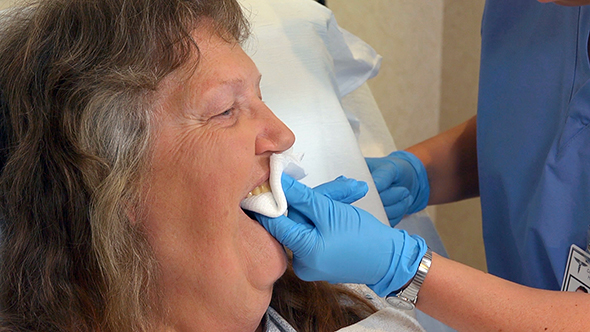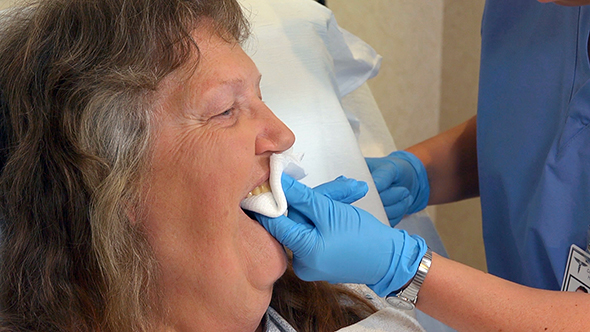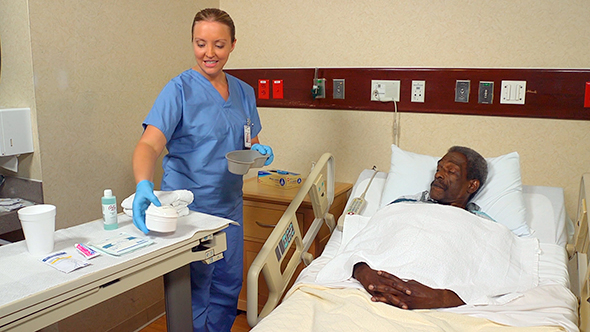Personal Hygiene and Grooming
Select a Skill:
- » Performing Oral Hygiene
- » Providing Denture Care
- » Brushing and Combing the Person's Hair
- » Shampooing the Person's Hair
- » Shaving the Person's Face
- » Giving Nail and Foot Care
- » Assisting with Undressing and Dressing
- » Changing the Gown of the Person with an IV
Take the Review Test:

Purpose

- A denture is an artificial tooth or set of artificial teeth. Often called “false teeth,” dentures replace missing teeth.
- Mouth care is given and dentures cleaned as often as natural teeth.
- Dentures are slippery when wet. They easily break or slip if dropped onto a hard surface. Hold them firmly when removing or inserting them. During cleaning, firmly hold them over a basin of water lined with a towel.
- Use only denture cleaning products, following the manufacturer’s instructions. Hot water causes dentures to lose their shape. If not worn after cleaning, store dentures in a container of cool or warm water or denture-soaking solution.
- Dentures usually are removed at bedtime. Some people do not wear their dentures. Others wear them for eating and remove them after meals.
Equipment
Roll cursor over items to see labels. For the purposes of clearly depicting the equipment, a barrier is not shown in this photo. When providing care, a barrier should always be placed on the surface before placing the equipment.

Two hand towels
Kidney basin
Denture brush or toothbrush (for cleaning dentures)
Toothpaste
Soft-bristles toothbrush or sponge swabs (for oral hygiene)
Water cup with cool water
Mouthwash or solution noted on the care plan
Denture cup labeled with the person's name and room and bed number
Denture cleaning agent
Gloves
Paper towels
Gauze squares
Delegation
- Follow delegation guidelines. Before providing denture care, obtain this information from the nurse and care plan:
- The type of oral hygiene to give
- If flossing is needed
- What cleaning agent and equipment to use
- If you apply lubricant to the lips (If so, what lubricant to use)
- How often to give oral hygiene
- How much help the person needs
- What observations to report and record
- When to report observations
- What patient or resident concerns to report at once
Preparation

- Observe quality-of-life measures.
- Review the information under Delegation and Safety and Comfort.
- Practice hand hygiene.
- Collect the equipment.
- Place the paper towels on the over-bed table. Arrange items on top of them.
- Identify the person. Check the ID bracelet against the assignment sheet. Also call the person by name.
- Provide for privacy.
- Raise the bed for body mechanics.
Safety

- Dentures are the person’s property and are costly. Handle them very carefully. Label the denture cup with the person’s name and room and bed number. Report lost or damaged dentures at once. Losing or damaging dentures is negligent conduct.
- Never carry dentures in your hands. Always use a denture cup or kidney basin. You could easily drop the dentures as you move to and from the bedside and bathroom.
Comfort
- Many people do not like to be seen without their dentures. Privacy is important. Allow privacy when the person cleans dentures. If you clean dentures, return them to the person as quickly as possible.
- Persons with dentures may have some natural teeth. They need to brush and floss the natural teeth.
Procedure Video
Audio Description: OFFFollow-up Care

- Assist with hand washing.
- Provide for comfort.
- Place the call light within reach.
- Lower the bed to the low position. Raise or lower bed rails. Follow the care plan.
- Remove the towel from the sink. Drain the sink.
- Rinse the brushes. Clean, rinse, and dry equipment. Return the brushes and equipment to their proper place. Discard disposable items. Wear gloves for this step.
- Wipe off the over-bed table with paper towels. Discard the paper towels.
- Unscreen the person.
- Complete a safety check of the room.
- Follow agency policy for dirty linens.
- Remove and discard the gloves. Practice hand hygiene.
Reporting/Recording
- Report and record your observations, including:
- Dry, cracked, swollen, or blistered lips
- Mouth or breath odor
- Redness, swelling, irritation, sores, or white patches in the mouth or on the tongue
- Bleeding, swelling, or redness of the gums
- Loose or broken teeth
- Rough, sharp, or chipped areas on dentures
Review Questions
Select the best answer.
1. How should dentures be stored when they are not in the person’s mouth?
 In a glass of hot water at the side of the bed
In a glass of hot water at the side of the bed Wrapped in a washcloth in the bedside table
Wrapped in a washcloth in the bedside table In the person’s medicine cabinet in the bathroom
In the person’s medicine cabinet in the bathroom In a container of cool water or denture-soaking solution
In a container of cool water or denture-soaking solution
Select the best answer.
2. When cleaning dentures, which action helps promote safety?
 Store dentures in warm disinfecting solution
Store dentures in warm disinfecting solution Clean dentures with a soft cloth to prevent scratching
Clean dentures with a soft cloth to prevent scratching Label the denture cup with the person’s name and room and bed number
Label the denture cup with the person’s name and room and bed number Lower the head of the bed before removing dentures from the person’s mouth
Lower the head of the bed before removing dentures from the person’s mouth
Select the best answer.
3. When providing denture care, what step should you take?
 Help the person rinse the mouth with an antibiotic solution to prevent bad breath
Help the person rinse the mouth with an antibiotic solution to prevent bad breath Line the bottom of the sink with a washcloth to prevent damage in case dentures fall
Line the bottom of the sink with a washcloth to prevent damage in case dentures fall Rinse dentures well in hot water and inspect them, noting cracks, rough areas, or loose teeth
Rinse dentures well in hot water and inspect them, noting cracks, rough areas, or loose teeth Brush dentures with a back-and-forth motion, using a paste of baking soda or salt and water
Brush dentures with a back-and-forth motion, using a paste of baking soda or salt and water
Select the best answer.
4. If a person cannot remove his or her dentures, how should you proceed?
 Use gauze squares to remove slippery dentures
Use gauze squares to remove slippery dentures Wear special gloves to remove the person’s dentures
Wear special gloves to remove the person’s dentures Perform oral hygiene with dentures in the person’s mouth
Perform oral hygiene with dentures in the person’s mouth Use both thumbs to wiggle dentures and break the seal for removal
Use both thumbs to wiggle dentures and break the seal for removal
Select the best answer.
5. If you need to insert a person's dentures, how should you hold them?
 With both thumbs
With both thumbs With three fingertips
With three fingertips With your thumb and index finger
With your thumb and index finger With your thumb and middle finger
With your thumb and middle finger
You have completed the Review Questions for this skill. To take the Review again select the Start Over button. To proceed to another skill select from the dropdown menu. Select the Home or Back button to proceed to the next section.

